

Join SCS Engineers at WEFTEC 2025, North America’s largest annual event for water quality professionals. Hosted by the Water Environment Federation, WEFTEC brings together thousands of innovators, engineers, operators, and industry leaders to exchange knowledge, explore cutting-edge technologies, and shape the future of water quality.
Why Visit SCS at WEFTEC?
Connect with our experts in wastewater, stormwater, and sustainable infrastructure
Learn how we’re solving complex water challenges with practical, science-driven solutions
Discover our latest innovations in water treatment, PFAS mitigation, and data-driven operations
Whether you’re joining a technical session, exploring the exhibit floor, or networking at one of the many events, don’t miss the opportunity to engage with the SCS team. We’re passionate about protecting our water resources—and partnering with communities, utilities, and industries to do it better. Register now!
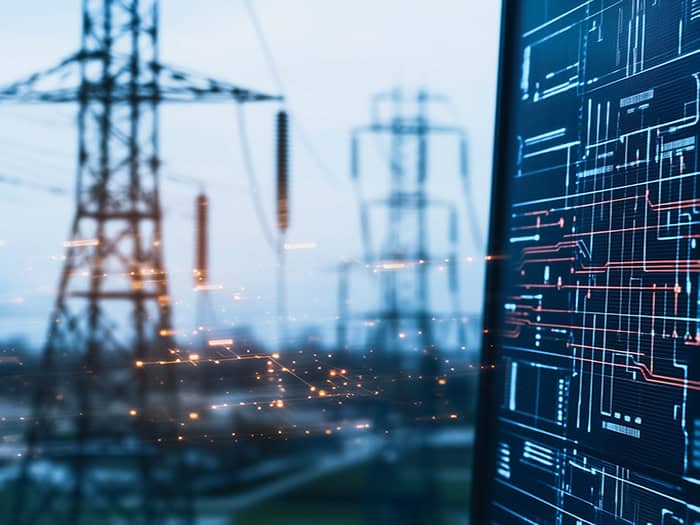
An energy company using coal (many still do as they transition to renewable energy sources) uses desulfurization for its flue gas, preventing air pollution and creating gypsum as a by-product. Fly ash, another by-product of creating energy, is sold to concrete companies for a profit. The wastewater used in these green processes has high chloride. It is pretreated to ensure the chemistry of the wastewater is safe before injecting it into an EPA and state regulatory agencies-approved Class I well below drinking water aquifers.
Pretreatment helps to ensure the energy company does not decrease the capacity of the well to accept wastewater. Chemical characterization of the wastewater in the permitting process and regular sampling during operations helps ensure the fluid is non-hazardous and unchanged.
Using green practices, this energy company prevents air and water pollution, protects drinking water resources, and qualifies as a zero-discharge facility. The bottom line is that they provide energy at a reasonable cost; the company is profitable from its green practices and protects health and human life.
That’s sustainability that empowers the safety of electric utilities as they provide for our energy needs.
You are welcome to make use of SCS Engineers’ extensive library of papers, blogs, and videos for the power sector. Here are a few suggestions:
 Professional Geologist Jake Dyson is responsible for permitting, drilling, regulatory compliance, and operating Class I, II, V, and VI UIC wells. Dyson manages permitting, testing, and workovers of UIC wells and serves his clients as a technical advisor on developing and executing well construction material, formation fluid, and well testing programs, including managing drilling and construction costs, interpreting geologic data for model inputs, and developing static geologic models. You can reach Jake at SCS Engineers or on LinkedIn.
Professional Geologist Jake Dyson is responsible for permitting, drilling, regulatory compliance, and operating Class I, II, V, and VI UIC wells. Dyson manages permitting, testing, and workovers of UIC wells and serves his clients as a technical advisor on developing and executing well construction material, formation fluid, and well testing programs, including managing drilling and construction costs, interpreting geologic data for model inputs, and developing static geologic models. You can reach Jake at SCS Engineers or on LinkedIn.
Join SCS Engineers at the 2024 Food and Beverage Environmental Conference on April 16-19! The conference will be held at Hotel Effie in Miramar Beach, FL.
The 2024 Food and Beverage Environmental Conference (FBEC) is a premier gathering for environmental professionals in the food and beverage industry nationwide. Discover the latest trends in sustainability, water management, supply chain dynamics, air quality, environmental compliance, and professional development.
At the Food and Beverage Environmental Conference, delve into an array of topics crucial to environmental stewardship in the food and beverage sector. From craft breweries to pet food manufacturers, grocery stores, and stakeholders in nutrition, farming, and processing, explore the entire industry spectrum. Join us for insightful discussions and networking opportunities.
Click here for schedule, registration, and other conference details.
Join SCS Engineers at the 2024 Food and Beverage Environmental Conference on April 16-19! The conference will be held at Hotel Effie in Miramar Beach, FL.
The 2024 Food and Beverage Environmental Conference (FBEC) stands as the premier gathering for environmental professionals within the food and beverage industry across the United States. This event serves as a pivotal platform for exploring the latest trends and innovations influencing sustainability, water resource management, supply chain dynamics, air quality enhancement, environmental compliance, and professional development.
At the conference, attendees will be able to delve into a diverse array of topics crucial to environmental stewardship in the food and beverage sector. From craft breweries and distilleries to pet food manufacturers, grocery stores, and stakeholders involved in nutrition, farming, processing, transportation, distribution, and supply chain management, the Food and Beverage Conference encompasses the entire spectrum of industry involvement.
For more information and registration click here!
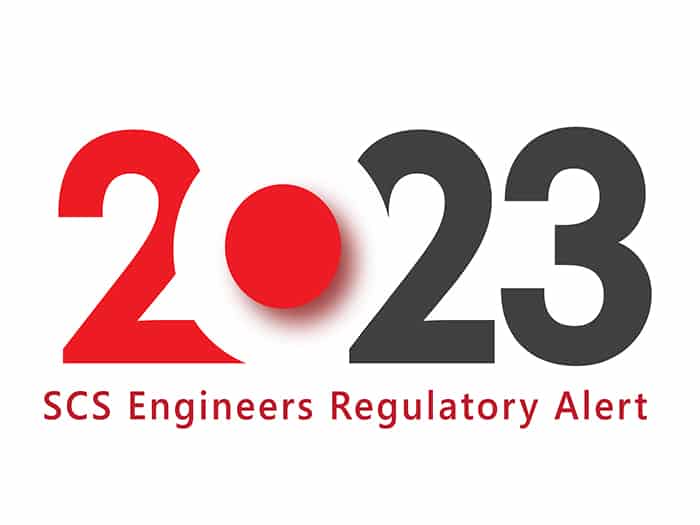
USEPA recently issued Effluent Guidelines Program Plan 15, which includes a focus on PFAS discharges from multiple categories. In conjunction with Plan 15, EPA has determined that revisions to the effluent guidelines and standards for the Landfills Category (40 CFR part 445) are warranted. See Section 6.3.3 of the Plan. Here are a few excerpts regarding landfill leachate:
Landfill leachate and wastewater treatment planning and resource information are available here.
SCS Engineers is a sponsor of the 2023 Food and Beverage Environmental Conference taking place March 26-29, 2023, at the Hyatt Regency Incline Village in Lake Tahoe, Nevada.
FBEC is the premier and most comprehensive environmental event for the food and beverage industry in the United States. It brings together industry, academia, non-government organizations, and suppliers in a casual atmosphere that allows for the free flow of information and ideas. The conference includes a single program of sessions, information exchange, poster sessions, and socializing and networking events, all of which uncover the latest trends and innovations affecting water reuse, supply chain challenges, air quality and many more.
The 2023 Conference will explore the following topics and more!
Participants and attendees include craft breweries and distilleries, pet food makers, grocery stores, nutritionists, farmers, and food and beverage processors, as well as those involved in transportation, distribution, preparation, supply chain management, EHS, sustainability and wastewater solutions.
Deep injection wells (DIW) mean different things in different parts of the country. In the midwest DIWs have been used for decades to dispose of industrial wastewaters, mining effluent, and produced water from oil and gas production activities and are from 3,500 feet to more than 10,000 feet deep. In Florida, deep injection wells have been used since the 1960s; however, they are used to dispose of treated municipal wastewater, unrecyclable farm effluent, and in some cases landfill leachate. DIWs in Florida range from 1,000 feet to around 4,500 feet deep.
This is a two-part blog, the first part discussing what constitutes a DIW, their general features, their cost relative to other wastewater management alternatives, and the range of industrial wastewaters suitable and safe for disposal. The second part, covered in the next SCS Environment issue, will be on the challenges for deep well developers created by public and environmental organizations, and strategies to counter misinformation and means to obtain consensus from stakeholders.
A DIW construction is a series of casings set in the ground where the initial casing starts out large and subsequent casings become smaller in diameter, progressively telescoping downward. Casing materials are typically steel alloys or fiberglass for better chemical resistance. As a casing is set and rock is drilled out, the next casing is set and cemented with a chemically resistant grout. The process continues with each progressively deeper casing. These redundant “seals” are what keep the injected liquid from escaping into the protected aquifers.
A DIW typically has three upper casings to protect the aquifers and isolate the wastewater to the desired disposal zone. The inner casing, called the injection tube, extends to the injection zone. Mechanical packers seal the space between the injection tube and the last casing with the annular. The resulting annular space is filled with a non-corrosive fluid. This fluid is put under pressure to demonstrate the continuous mechanical integrity of the well. The annulus is monitored for potential leaks, which would register as a loss in pressure and promptly stop the injection. Figure 1 is a simplified view of a DIW casing system used in south Florida.
Vertical turbine pumps working in conjunction with a holding tank, which is a used to smooth out the fluctuating flow of the wastewater feed pumps, propel the liquid down the well. As part of the permitting efforts, a chemical compatibility study is conducted to determine the level of pre-treatment if any to protect the well components and minimize downhole plugging. Municipal wastewater effluent is regulated differently and must receive at least secondary treatment before injection.
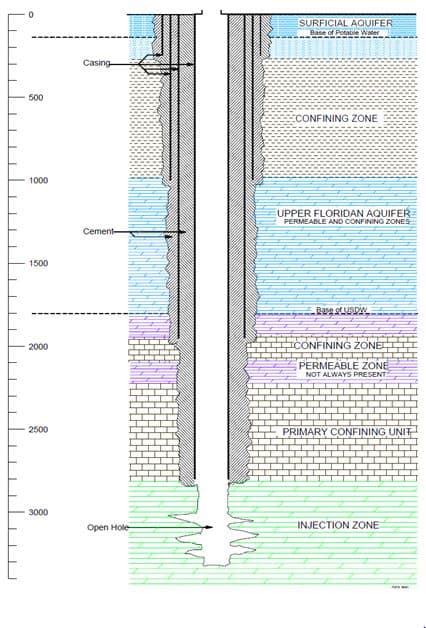
In the Midwest, DIWs are constructed to the same EPA criteria with a wide range of operating conditions. Some wells take fluid under gravity with no pumping, while others require higher pressure pumps that exceed 2,500 psi for injection. This blog focuses on wells used in Florida and typical fluid types and operational parameters.
In central and south Florida the injection zone lies below the underground sources of drinking water (USDW) which is the depth at which water with a total dissolved solids (TDS) concentration exceeds 10,000 parts per million (ppm); or the “10,000 ppm line”. This water is considered to be unusable in the future as a drinking water source. In parts of Florida, the injection zone is dolomite overlain by a series of confining units up to 1,000 feet thick made up principally of limestone with permeability several orders of magnitude less than the injection zone. (1)
In central and south Florida the target injection interval is the “Boulder Zone,” reportedly named because drilling into the formation often broke off pieces of the formation and made drilling difficult. The Boulder Zone is also known as the lower portion of the Floridan Aquifer. Later down-hole imaging technologies revealed this zone to be characterized by highly fractured bedrock and large karstic caverns, and the ability to inject relatively high flow rates with relatively little backpressure. It is not uncommon for Florida DIWs to have well flow rates exceeding 15 million gallons per day (MGD) and backpressures ranging from 30 up to 100 pounds per square inch (psi).
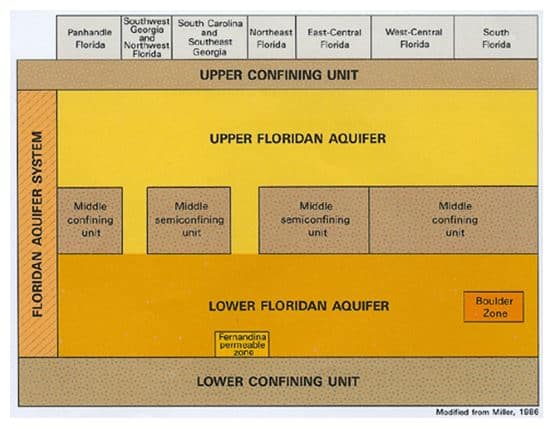
The versatility of the DIW in Florida to accommodate numerous different types of wastewater is an advantage. DIWs are being used on a large variety of waste streams that continues to expand, including:
Any wastewater considered for disposal must be compatible with the target formation and the final casing material. Therefore, depending on the wastewater, it may be straightforward to use existing industry references to confirm compatibility. In some cases, laboratory bench tests may be necessary to confirm compatibility.
Compatibility also includes the potential for creating unwanted microbial growth and scale formation within the injection interval. Growth and scale can happen with effluent containing sulfur or ammonia, two food sources for microorganisms or wastewaters supersaturated with minerals. Unless planned for and evaluated properly, both of these items have the potential to grow and clog the formation around the well, significantly reducing flow and increasing back pressure. This can result in higher energy costs, regulatory action and significant, unplanned costs to rehabilitate the well.
Another significant aspect of municipal wastewater is that they are primarily composed of freshwater and thus when injected into the highly saline Boulder Zone or similar saline zones, will tend to have a vertical migration component because of the density difference and greater buoyancy than the target zone. A few wells have been taken out of service because the seals designed to prevent this migration failed and allowed wastewater to seep upwards into the USDW.
The US EPA Underground Injection Control (UIC) program is designed with one goal: protect the nation’s aquifers and the USDW. There are several protective measures in a DIW that are intended to meet this objective;
The U.S. EPA conducted a study in 1989-1991 of health risks comparing other common and proven disposal technologies to deep wells injecting hazardous waste. The U.S. EPA concluded that the current practice of deep well injection is both safe and effective, and poses an acceptably low risk to the environment. In 2000 and 2001 other studies by the University of Miami and U.S. EPA, respectively, suggested that injection wells had the least potential for impact on human health when compared to ocean outfalls and surface discharges(3). William R. Rish examined seven potential well failure scenarios to calculate the probabilistic risk of such events.These scenarios included four types of mechanical failures, two breaches of the confining units, and the accidental withdrawal of wastes. The overall risk was quantified by Rish as from 1 in 1 million (10-6) to 1 in 100 million (10-8) (4), which is no greater than the current EPA risk criteria for determining carcinogen risk. As a comparison, 10-6 is the same risk level used by EPA for contaminants in soil or groundwater that are a known carcinogen.
There are several studies in Florida conducted by researchers and practitioners in the deep injection well field to assess the actual potential for municipal wells to contaminate the USDW. The maximum identified risk associated with injection well disposal of wastewater in south Florida is the potential migration of wastewater to aquifer storage and recovery (ASR) wells in the vicinity of injection wells (Bloetscher and Englehardt 2003; Bloetscher et al. 2005).
In a 2007 study, 17 deep wells in south Florida, used for municipal waste disposal, that had known upward migration into the USDW, were evaluated to develop a computer model to simulate these phenomena and extrapolate vertical migration over longer time periods. The results indicated that the measured vertical hydraulic conductivities of the rock matrix would allow for only minimal vertical migration. Even where vertical migration was rapid, the documented transit times are likely long enough for the inactivation of pathogenic microorganisms (5).
In a 2005 study of 90 South Florida deep injection wells, the authors took actual field data and constructed a computer model calibrated to actual operating conditions. The intent was to model performance of two injection wells in the City of Hollywood, Florida that the authors were familiar with and to determine the likelihood of migration, and what might stop that migration. Density differential and diffusion were likely causes of any migration. No migration was noted in Hollywood’s wells. The preliminary results indicate that Class I wells can be modeled and that migration of injectate upward would be noticed relatively quickly (3).
A deep injection well lifecycle cost compares favorably with other traditional waste treatment and disposal techniques. A life-cycle cost includes the capital cost and operating and maintenance costs for the useful life of the system. On a recent project, the wastewater for disposal was groundwater contaminated with ammonia nitrogen from a former landfill. The estimated groundwater recovery rate and the deep injection well disposal rate was calculated to be 1.2 million gallons per day (MGD). The proposed deep well was designed to have a final casing of 12-inch diameter, an 8-inch diameter injection tubing to a depth of 2,950 feet, and below that approximately 550 feet of open bore hole. The lifecycle cost estimate comparison to other viable technologies is shown in the Table below.
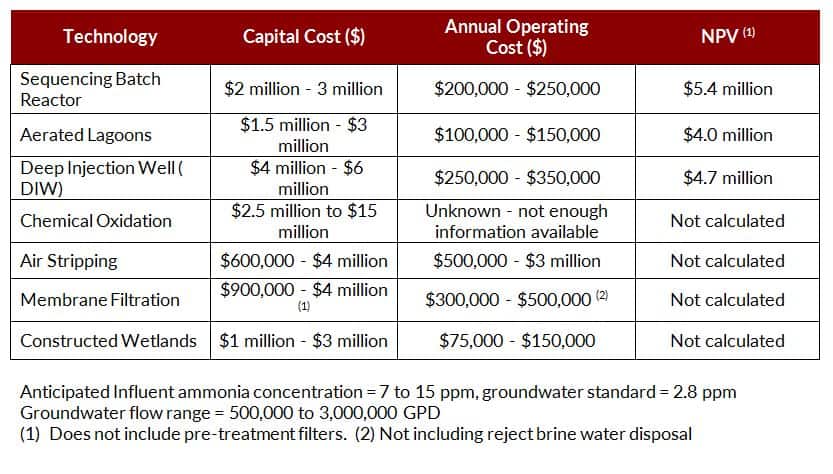
In this case, there were no projected revenues, so the alternative with the lowest net present value (NPV) would technically be the preferred alternative. Even though the aerated lagoon had the lowest NPV, it was ultimately judged too risky with a long break-in treatment period and significantly more space for treatment ponds needed.
The increasingly stringent surface water discharge standards are an ongoing challenge for industries generating a wastewater stream. DIW’s should be considered as a potentially viable option for long-term, cost-effective wastewater disposal, where a viable receiving geologic strata exists and when wastewater management alternatives are evaluated. In Florida, they currently provide an environmentally sound disposal option for many regions.
Within the SCS Engineers’ website, you will find the environmental services we offer and the business sectors where we offer our services. Each web page offers information to help you qualify SCS Engineers and SCS’s professionals by scientific and engineering discipline.
We provide direct access to our professional staff with whom you may confidentially discuss a particular environmental challenge or goal. Our professional staff work in partnership with our clients as teams. We are located according to our knowledge of regional and local geography, regulatory policies and industrial or scientific specialty.
Ann O’Brien of SCS Engineers has pulled together a list of questions that printers should be asking themselves before the environmental reporting season is upon us.
Use Ann’s questions as a guide to find out how ready your company is, and decrease your risk of non-compliance by being more organized.
If you don’t know the answers, ask Ann. She’s one of our air and water permitting, monitoring, and reporting experts at SCS. Ann specializes in printing industry compliance.
Contact and we’ll direct you to an air, storm water, wastewater, or groundwater expert near you and in your industry.
ButterBuds® Food Ingredients supply their concentrated dairy flavors to consumers and food businesses all over the world. ButterBuds called in SCS Engineers to help them lower the concentrations of fats, oils, and grease (FOG) in their wastewater.
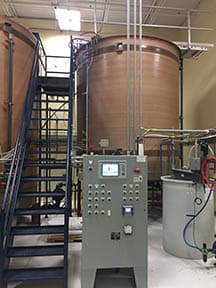
Fats, oils, and grease (FOG) cause wastewater issues for food ingredients and food manufacturers. These companies must keep an eye on their compliance schedules to keep ongoing production from being disrupted.
For ButterBuds, SCS Engineers began by carrying out a multi-level review of the wastewater pretreatment issues. We conducted a process water balance, prepared a process flow diagram, measured process flows, collected/analyzed wastewater samples, evaluated chemical treatment testing and maintained communications with City staff.
The SCS team prepared engineering design drawings and specifications for the wastewater pretreatment system. We also helped ButterBuds staff with the selection of wastewater pretreatment equipment, bidding, construction, and start-up, as well as resolving operational issues.
The wastewater treatment equipment was housed in a separate building away from the food ingredient processes. This requirement meant the wastewater discharge piping had to be installed underneath the existing building using directional drilling to minimize any disturbance to production.
Outcomes and benefits
A variety of CCB/CCP related topics guaranteed to enhance your knowledge. Click the title to read or share these papers.

Jeff Marshall – Mitigating Hydrogen Sulfide Issues at Coal Combustion Residuals and Municipal Solid Waste Co-disposal Sites – Learn about the biological, chemical and physical conditions necessary for FGD decomposition and hydrogen sulfide generation. Marshall will explore technologies that remove and treat hydrogen sulfide from landfill gas and present recommendations for reducing the potential for FGD decomposition at co-disposal facilities.
 Eric Nelson and Lindsay Motl – Working Through Location Restrictions to Expand the Ottumwa Midland Landfill – The final Coal Combustion Residual (CCR) rule introduces new challenges for companies developing new landfills or expanding existing sites. Join us to learn how Alliant Energy overcame these challenges and expanded the Ottumwa Midland Landfill (OML) to accommodate increased byproduct disposal rates from new emission control projects.
Eric Nelson and Lindsay Motl – Working Through Location Restrictions to Expand the Ottumwa Midland Landfill – The final Coal Combustion Residual (CCR) rule introduces new challenges for companies developing new landfills or expanding existing sites. Join us to learn how Alliant Energy overcame these challenges and expanded the Ottumwa Midland Landfill (OML) to accommodate increased byproduct disposal rates from new emission control projects.

 Steve Lamb and Floyd Cotter – Selecting the Right Closure Cap Option for Your Surface Impoundment or CCR Landfill – Alternative capping options have recently emerged in the industry, such as exposed geomembrane liners or synthetic turf/geomembrane liner systems. Some of these alternative capping options have many advantages over their traditional counterparts. These experts describe the advantages and disadvantages of alternative capping options.
Steve Lamb and Floyd Cotter – Selecting the Right Closure Cap Option for Your Surface Impoundment or CCR Landfill – Alternative capping options have recently emerged in the industry, such as exposed geomembrane liners or synthetic turf/geomembrane liner systems. Some of these alternative capping options have many advantages over their traditional counterparts. These experts describe the advantages and disadvantages of alternative capping options.